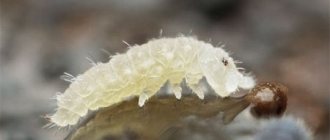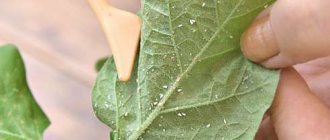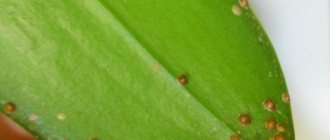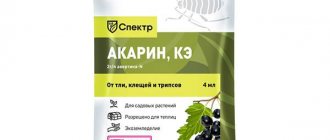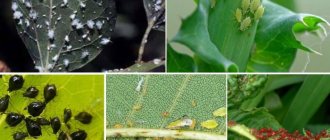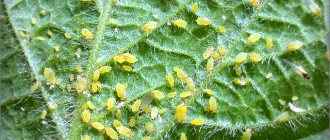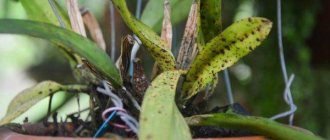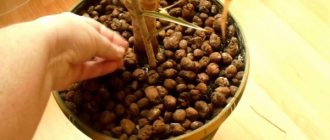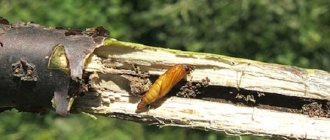Where to start fighting mealybugs
At first glance, it is difficult to understand that the bush is infected with an insect, since the crop is covered with a white coating similar to fungus or mold.
Therefore, at the initial stage, it is important to decide what you still have to fight. After this, you need to use one of the popular methods of insect control. This can be done using proven chemicals or using traditional methods. It is important to complete the job and completely get rid of the pest. As a rule, it will take 10-12 days to completely defeat insects.
Attention! It is necessary to treat nearby crops to avoid re-infection.
What kind of worm is there?
This is an insect with an oval body. It has bristles on the sides, and the whole body is covered with a white coating. Stripes are usually visible across the back, so the pest can be seen without special tools. The maximum size of the insect is 7 mm, the minimum is 3 mm.
When the mealybug sprays its sticky mucus, it appears as if the flower is covered in flour. Under it you can find a mealybug and the eggs it lays. The mealy consistency interferes with proper gas exchange.
Most often, the insect can be seen on young twigs and even flower buds. There are situations when they appear on windowsills or on the soil itself in a pot. In total, more than one and a half thousand varieties are known in the world, but the presence of bristly, grape, citrus and seaside scalebugs is very dangerous for indoor plants.
Among the plants on which the pest may appear are:
- Amaryllis;
- Cactus;
- Palm;
- Monstera;
- Kalanchoe;
- Hibiscus and others.
Reasons for appearance
Mealybug infestations can occur at any time of the year, but are more likely to occur in late summer and fall.
If the plant is not properly cared for, there is a risk of mealybugs appearing.
The causes of scale insects are quite varied and include:
- low room temperature;
- waterlogging of the soil used;
- untimely removal of dead areas of plants;
- using contaminated soil or transplanted plants.
Without timely prevention, these pests can reproduce in warm rooms almost all year round.
Why is it dangerous and where does it come from?
Mealybugs are like a time bomb for...
It is dangerous because the plant easily becomes infected and dies quickly. The latter occurs due to the fact that the insect simply sucks out the juice. The pest can be located both in the root system and in the axils of the leaves. Let's take a closer look at where the mealybug comes from.
So, mealybugs can be found anywhere in the world. They reproduce quickly. The female can lay up to 400 eggs at a time. They appear on plants for various reasons.
For example, you yourself could bring it on your clothes, of course, if you came into contact with an infected plant. At the same time, the possibility that they flew in on their own is excluded: the insects belong to the order Hemiptera, whose wings are poorly developed. And females are completely wingless.
Signs of plant damage
At first glance, a mealybug infestation does not look like an insect infestation and is often mistaken for mold or mildew. This is due to the fact that a growing colony of scale insects looks like white cobwebs, fluff, or drops of sticky cotton wool.
Female mealybugs lay eggs on plants in white, fluffy, shapeless egg sacs consisting of waxy cobweb secretions. The bags are usually placed in secluded places of plants - in cracks in the bark, along the stems, in the axils of the leaves or under the leaves themselves.
Colonies also produce nectar, a sticky substance that attracts ants and encourages the growth of black fungal mold. If you stir the colony, it feels wet and sticky to the touch.
As the scale insects multiply, a loose powdery coating appears on the plant, consisting of white waxy deposits and insects.
The affected plant may drop leaves
Adult females and mealybug larvae drink the juice of young shoots, leaves and buds of the plant, which significantly inhibits its development and growth.
Plant infection can also be indicated by lost elasticity, deformed, yellowed, or dead leaves, as well as drooping flowers. It becomes covered with spots, slows down its growth and takes on a depressed appearance. In addition, through the damage caused by the scale insect, the plant is affected by secondary infections.
A subspecies of the pest, the so-called citrus mealybug, attacks the roots. It grows more in pots with dry soil mixture, forming root “feeders”, as well as white, rough masses around the roots. They can be detected by freeing the plant from the pot.
Pests attack a wide range of indoor plants. Cacti and succulents are especially vulnerable to their presence, including coleus, croton, fern, African violet, begonia, orchid, ficus, dracaena and pelargonium.
How to get rid
Of course, you need to get rid of this sucking parasite as quickly as possible. The sooner you start fighting it, the easier it will be to do it. In addition, the plant’s chances will increase that it will survive and continue to please those around it. But not everyone knows how to get rid of mealybugs.
Before you start treating the flower with any preparations, it is necessary to carry out a complete treatment, which takes place in several stages:
- Completely replace the soil. In any case, it is infected with this pest and its larvae.
- The plant is thoroughly washed with water, but remember that it will not have any effect on the eggs.
- Inspect the flower with a magnifying glass. Be sure to take a good look at the root system.
- Using a small brush, remove all larvae.
- Cut off all dead and very affected areas.
How to remove mealybug and what method of control to choose?
You can get rid of this pest in 2 ways: traditional methods and using insecticides.
Method 1
There are many decoctions that can be used to destroy mealybugs, but the most effective among them are the following:
- A decoction of calendula or horsetail. You need to take 100 g of any of these plants and pour a liter of boiling water over them. After the tincture has cooled, spray the plant with it.
- Garlic tincture. Finely chopped garlic is poured with water for 4 hours. After this, moisten the sponge with the resulting product and wipe the flower thoroughly.
- Olive emulsion. Dissolve 2 tablespoons of olive oil in a liter of water and spray the plant with the resulting solution.
- Soap-alcohol solution. Dissolve a teaspoon of liquid soap and a tablespoon of alcohol in one liter of water (can be replaced with 1.5-2 tablespoons of vodka). The plant should be sprayed very carefully with this solution, making sure that the product does not get into the soil under any circumstances. In addition, the solution must be washed off every other day. Spraying can be repeated, but not earlier than after 72 hours.
If traditional methods do not help and a whole colony of mealybugs continues to live on the plant, then you should definitely use chemical treatment.
Method 2
All chemicals that help fight this pest are divided into 3 groups:
- Intestinal. The parasite enters the body through the mouth. One of the best among them is Actellik.
- System. These are excellent helpers in the fight against mealybugs, which exist in the form of a spray. The leaves of the plants absorb them, and then the pests suck out the poisoned juice and die. Good means of such a group are Mospilan and Aktara.
- Contact. They have a negative effect on mealybugs through the skin. A striking example is the German drug Spruzit AF Schadlingsfrei.
Chemicals work well on young larvae that are not covered with protective wax; the older the larva, the harder it is to destroy it. In this regard, chemical treatment is repeated about 3 times every week or two.
We have figured out what rule to use to choose a remedy for mealybugs, now it’s worth talking about preventive measures.
Preventive measures
It should also be remembered that it is easier to prevent mealybugs than to fight them. To do this, you must observe the following precautions:
- Inspect the plant regularly, paying particular attention to suspicious formations or lower leaves.
- It is imperative to remove all dry and frozen parts of plants, since the smell of rot attracts various pests, including mealybugs.
- Spray the flowers or wipe them with a sponge.
- If you have purchased a new indoor plant, place it separately from other flowers and observe it. Take a good look to see if you brought some kind of pest into your home.
Do you think mealybugs are dangerous to humans? You can rest assured that this pest does not pose a threat to the human body, but it is quite capable of destroying a plant. Watch a video on how to get rid of mealybugs on an orchid using Aktara:
A person who purchases a houseplant may encounter various troubles. Sometimes it is very difficult to remove the same mealybug, but the beauty that indoor flowers give us is worth it. Therefore, under no circumstances should you give up and give up. You always need to do everything to save the plant from this pest.
Pesticides against mealybugs
In cases where traditional methods do not help, they resort to special chemicals. They are also used for preventive treatment of suspicious newly acquired specimens.
Aktara
Mealybugs are protected by a strong shell and a dense waxy coating, so they successfully resist contact pesticides. Not all chemicals can cope with mealybugs. To destroy felt weeds, you can use organophosphorus compounds based on malathion (Fufanon-Nova, Karbofos), but modern insecticides - neonicotinoids, especially Aktara, will be much more effective.
Important!
Aktara (active ingredient - thiamethoxam) is the simplest and most reliable chemical remedy for mealybugs.
Aktara is diluted in a dosage of 1 g of dry powder (or 1 ml of liquid concentrate) per 1 liter of water. The solution is sprayed and simultaneously watered at the roots of the plants. The procedure is repeated three times with an interval of 7-10 days. The product does not affect egg laying, so one spray is not enough. If you need to treat many plants prophylactically, then for watering the concentration of the solution is reduced 10 times (take 1 g per bucket of water), but the effect may be weaker.
After watering with Aktara, the roots absorb the chemical, and it penetrates into the cell sap. This poisons the sucking insects as they feed. A similar active ingredient is contained in such a preparation as Doctor 8 arrows sticks. They are stuck into potting soil for preventive protection against pests.
Analogs
In addition to Aktara, other neonicotinoids with similar effects can cope with mealybugs - in particular, imidacloprid (drugs Confidor, Confidelin, Imidor) and acetamiprid (Mospilan, Stozhar). Confidor Extra is used similarly to Aktar.
Root treatment
If a mealybug is found in the underground zone, then the roots are thoroughly washed in running water and then soaked for a quarter of an hour in any of the insecticides mentioned above. Then the plant is planted in a disinfected pot and clean soil. It is advisable to water with Aktara or stick Doctor 8 arrow sticks into the ground (for prevention).
It should be remembered that after using pesticides, the waiting periods recommended in the instructions (usually 3-4 weeks) must be observed if the indoor plant or its fruits are used for food purposes (lemons, pomegranates, spices, medicinal herbs, etc.).
Biological insecticides (Fitoverm, Lepidotsid, etc.), as a rule, do not help in the fight against mealybugs.
Control measures
Getting rid of mealybugs is quite difficult, since insecticidal preparations act only on adult individuals, without harming the eggs and larvae. To completely eradicate pests, a cycle of at least three chemical treatments is required.
The best means of combating scale insects are considered to be Fitoverm, Vertimek and Actellik - insectoacaricides of enteric contact action, low toxicity for humans and animals, and therefore suitable for treating indoor plants. Among the ovicides, Nissoran, Apollo and Para Plus are popular.
To destroy the entire population of scale insects, it is necessary to carry out 3-4 cycles of treatments, alternating the insecticide with the ovicide. The activity should be carried out like this:
- All visible pests are manually removed from a diseased flower (you can do this with a cotton swab dipped in alcohol or vodka). All flowers along with peduncles are removed from a flowering plant. If we are talking about an orchid, it is better to remove it from the pot and rinse thoroughly under moderately hot water (45-50 ° C). Not only the leaves, but also the roots should come under the stream of water. In monopoidal orchids, after the procedure, carefully blot the leaf sinuses and growth point with a napkin.
- The plant is sprayed with ovicide, following the instructions for the drug and all safety measures prescribed when working with chemicals. The treated orchid is planted in a sterilized pot with a new substrate, and all old bark is disposed of.
- After 2-3 days, the flower is sprayed with an insecticidal preparation. A week later, the treatment cycle is repeated in the same sequence.
- The infected plant must be isolated from the rest of the collection and its condition carefully monitored. Treatment is considered successful if there are no signs of mealybugs for a month.
Traditional methods
If you are categorically against the use of chemicals in residential areas, you can try to get rid of the pest using folk remedies.
Effective methods of pest control are:
- Garlic infusion. To prepare it, pass 4-5 large cloves of garlic through a press, pour a liter of boiling water over them and leave to steep for 4 hours. The plant is sprayed with the prepared infusion several times, with a seven-day interval between treatments.
- Green soap. You can purchase this product at any flower shop. The leaves of the plant are rubbed with it, like ordinary soap, and left for a day, after which they are washed off with plenty of warm water, preventing the soap solution from getting into the substrate. Some gardeners use flea shampoo for animals for the same purpose.
- Horsetail tincture. The drug is sold in pharmacies and is quite inexpensive. The infected plant is sprayed with horsetail tincture and the substrate containing the root system is spilled.
- Oil solution. A tablespoon of olive oil is diluted with a liter of warm water and the leaves of the diseased flower are sprayed.
Fungicide “Thanos”: properties and instructions for use of the drug
How to get rid of it?
How to deal with worms? You can resort to chemical means or try traditional methods that are more gentle on the plant. Often they are the ones that give excellent results. First you need to collect all the insects that are visible from the flower (using rubber gloves), and trim off the damaged leaves and stems.
Chemicals
Then it’s time to turn to chemical protective equipment. Today, stores offer them in fairly large quantities and at affordable prices.
- "Akarin." This is poison for the mealybug. It works within eight hours: insects lose the ability to feed and die within 24 hours. Two drops of the product are diluted per liter of water, the sheets are wiped on both sides with a cloth soaked in the solution.
- "Aktara". It acts in a similar way to Akarin, but faster – within half an hour after treatment. Used as a sprayer (1-2 grams of product per 10 liters of water) or as a watering agent (8 grams of Akarina per 10 liters). Can be used together with pesticides.
- "Bankol." It affects both the digestive and central nervous systems of insects, paralyzes them, and after two or three days the lice die. A gram of Bankola is dissolved in two liters of water. The flower is sprayed. Treat twice - with an interval of 10-15 days.
- "Vertimek". It works in a similar way to Bankol. Three days after treatment, the insects die. The drug is diluted according to the instructions on the package, sprayed on the flower and covered with polyethylene. Leave it in this form for a day. The downside of this product is its high toxicity to people. Use with caution.
- "Inta-vir". Affects the nervous system of parasites. Dissolve the tablet in 5-10 liters of water, spray the plant around the entire perimeter - both affected and healthy areas.
- "Karbofos". This product exists in the form of a powder, a concentrated emulsion, concentrates in ampoules or a ready-made, diluted solution.
- "Tanrek". It fights mainly against aphids and whiteflies. To protect against insects, the concentration of the product will need to be increased several times. Dilute 0.3-1 ml of Tanrek in a liter of water and spray the affected areas.
- "Fitoverm". A biological agent. Two milliliters dissolves in half a liter of water. The plant is sprayed during the day, since the active substances decompose only in the light. Three or four similar treatments are carried out.
We talked in detail about effective remedies for mealybugs here.
Folk remedies
More gentle types of protection are tinctures and solutions. You can prepare them yourself at home.
- Soapy solution mixed with alcohol. This is very easy to make and very effective. To prepare it, you need to grate laundry soap on a fine grater (the result should be the volume of a teaspoon) then dissolve in hot water (a small amount). Next, it is brought to one liter with water, 15 ml of alcohol is poured into the resulting mixture (can be replaced with vodka - 30 ml). Everything gets mixed up. Cover the soil with polyethylene and spray the plant. The next day you need to wash it with warm water. This treatment is repeated every three days.
- Garlic infusion. About 70 grams of garlic is crushed and poured with a liter of boiled water. It is infused for six to seven hours (can be left overnight), filtered, and sprayed with this solution.
- Calendula (tincture from the pharmacy). In this case, a ready-made store product is used. Soak a cotton pad in calendula and wipe the affected areas. The treatment is carried out two or three times, it is best to do this in the evening and in a dark place.
- Citrus infusion. It can be made from orange, tangerine, lemon and grapefruit peels. They are filled with water and infused for two days. Then a spoonful of liquid soap is added. The plant is sprayed with this infusion.
- Oil emulsion. Add two tablespoons of olive oil to a liter of warm water. The leaves of the plant are sprayed with a spray bottle.
How to deal with mealybugs on indoor flowers
Controlling the pest is quite difficult. The waxy coating of insects and their egg sacs protects them from drying out, as well as from the action of insecticides in the form of powders and solutions.
A pest detected in time will cause minimal damage to the plant.
Mechanical cleaning
Pests attach freely to plants, so they can be easily removed by hand.
Signs you have a mealybug
Since the mealybug sucks nutrients from the leaves, the leaves may be deformed, and the plant itself is greatly inhibited in growth.
It is necessary to look for mealybugs not only on the leaves, but also in the root system. As it turns out, it does well in pots too. That’s why I’ve recently fallen in love with transparent pots, because you’re less likely to miss some “uninvited guest.”
First, I cleaned all the leaves of plaque and insects using a cotton pad soaked in a solution of green soap. The soap remaining on the foliage and stems will help the active drug linger on the green part of the plant, rather than safely forming a droplet and draining from the leaf. Since I did not have time to wait for further manifestations of the mealybug, the next day I treated it with Fitoverm. There are a lot of drugs that are recommended for mealybugs, but I have been using Fitoverm for a long time, since it gives positive results for me.
I make a fairly strong solution: 2 ml of the drug per 200 ml of water for spraying and watering. First, I thoroughly irrigate the plants, and then pour them at the root. If possible, it is better to change the soil of the infected plant, since I had a recently purchased plant and I was going to change the soil and pot anyway, so I immediately did this. I bake the soil for all my plants in the oven so that when I change the soil, I don’t get any other pests. I even carefully cultivate the store soil.
I washed the roots with Fitoverm and thoroughly sprayed the green part of the plant. The treated plant can be left in quarantine for a week, and after a break the treatment can be repeated.
The waxy coating makes mealybugs very difficult to kill. Therefore, the poison will only affect young individuals. Adults will have to be removed manually. Because of this feature, the treatment can be repeated two to five times!
What harm can a mealybug cause?
If we talk about the harmful effects of these pests, then first of all they begin to pierce the skin of the leaves, as well as the stems. Through the resulting holes, they suck out the juice from the plant, which noticeably depletes it. In the process of drinking juice, the pest secretes saliva, which contains special enzymes. These components greatly slow down the process of photosynthesis and metabolism in the plant.
Those parts of the flower that are already attacked by the mealybug are seriously deformed. Unpleasant spots may appear on them, the shade may change, and much more. In addition, the active activity of pests leads to the formation of fungus (the so-called mob). If plants become too depleted due to mealybug activity, this means that they are more susceptible to a wide variety of infectious diseases. In this case, there is a high chance of destroying indoor flowers. There is also a type of mealybug that can even infect the root system of a flower. After this, the rhizome simply begins to rot and the entire plant dies.
How to recognize
Mealybug infestation of indoor plants is determined by the following signs:
- On the surface of the leaves you can see an incomprehensible nectar in the form of drops.
- On the stems, buds and leaves, as well as in the root zone, colonies of this pest are visible, similar to cotton wool with white cobwebs. There can be many such colonies. The more affected areas, the more difficult it is to cope with this pest.
- The stem begins to deform, and the growth of the flower is inhibited. At the same time, its appearance deteriorates.
- The leaves curl, turn yellow and begin to fall off as they lack nutrients.
- The action of the mealybug promotes root rot.
- If you do not fight this parasite in time, there is a risk of plant death.
- The life activity of the mealybug is distinguished by one feature: if there are no favorable conditions, then this parasite can remain in an inert state for a long time, that is, in a state of suspended animation. When the temperature and humidity reach the optimal level, the mealybug immediately begins active life, sucking the juices from the plant and continuing to reproduce.
Control measures
If a parasitic insect was noticed at an early stage, then the crown of the plant should be treated with a working solution based on laundry soap. It is prepared at the rate of 1 tsp. main component and 1 liter of boiling water, first grate the soap. A swab is moistened in this soapy liquid and, passing along the leaf plates, both cotton wool and pests are collected.
You can also try a warm shower, which allows you to get rid of mealybugs by 80%, but it is recommended to protect the soil with polyethylene. A week later, the manipulation should be repeated or walked with a swab dipped in a soap solution.
It is advisable to treat the rest of the decorative crops in the room in this way, also not leaving out the window sills, walls, and glass windows.
Chemicals
To get rid of mealybugs on indoor plants in advanced cases, you need to use strong chemicals. These means of control will allow you to destroy not only adults, but also larvae and eggs.
The effectiveness of a systemic insecticide lies in its ability to penetrate into the green space, passing both into the root system and the above-ground part. As a result, it turns out that no matter where the parasite is, it will still die from the poisoned juice. For complete guarantee, it is better to carry out another insecticide treatment after 7 days.
There are several groups of chemicals used against sucking insects:
- Systemic, capable of penetrating into the flower through the pores. The drug makes the juice poisonous to the pest. Rogor and Phosfamide, which contain malathion and parathion, are especially popular among gardeners.
- Intestinal, characterized by the ability to penetrate the body of a mealybug through its mouthparts. Products such as Aktary, Aktellika, Nurell-D are very effective.
- Contact action, entering the body of the parasite through the skin. The drug of the Spruzit-A ESchadlingsfrei group is especially valued. Its advantage is that there is no need for re-processing.
In-demand insecticides include preparations containing components such as malathion, dimethoate, parathion, and diazinon. Considering the fact that representatives of all generations are present on the plant, which requires several applications of the selected product, for example, Fitoverm.
If you use an insecticide in the form of a spray, you must read the instructions and find out all the details of its use, in particular, from what distance you need to spray it in order to avoid harm to the leaves of the flower.
Traditional methods
Among the natural remedies for combating mealybugs, choose:
- Olive oil based emulsion. To prepare it you will need 1 liter of warm water and 2 tbsp. l. main component.
- A working solution of liquid soap (20 g), warm water (1 l) and medical alcohol (20 g). This liquid is also used for wiping sheet plates.
- Garlic infusion. You can prepare it from ½ liter of boiling water and 4-5 cloves of chopped garlic. The infusion time is 4 hours, after which the mixture is passed through filter material and brought to the original volume. Leaves are processed both from the outside and from the inside.
Types of pests
Science knows over 1,500 varieties of mealybugs. They can be found all over the world, but most often in tropical latitudes. However, a significant proportion of them are insect pests that parasitize greenhouse and house plants.
The most dangerous for indoor plants include the following.
Bristlebug
The greatest danger is posed by larvae and females. The female’s body is 3-4 mm long, the body shape is oval, slightly elongated, the color is pink or light orange, the parasite is covered with a whitish coating. Usually accumulates on the back of the leaves.
The bristlebug is a very large insect, so it can be seen on a flower by the light powder with which its body seems to be “strewn”, as well as by waxy drops that visually resemble cotton balls. Over time, sooty fungi settle on these secretions. The affected leaves turn yellow quite quickly, and further growth and development of young shoots is suspended.
Grape bug
Females of this species have a rather wide oval body of a yellow or pinkish hue, it is covered with a powder resembling flour. The 1st instar larvae rapidly disperse throughout all green parts of the flower, forming huge colonies on leaves near the main veins and on new shoots. With significant damage, pests are able to suck all the juices out of a green pet - this in the shortest possible time leads to drying out of the plant and its complete death.
Primorsky mealybug
It is considered one of the most common. The length of the female's body reaches 4-5 mm, and the width is 2-2.5 mm, the color is gray-pink with a pronounced flour-like coating. The larvae are quite small, yellow, completely devoid of powdery coating, and at the same time extremely active.
They can be easily carried by the wind and very quickly disperse throughout the above-ground part of the flower. The transformation of a larva into an adult takes about 1-1.5 months; colonies of sooty fungi are formed on the secretions of parasites. The affected plant dries out, its leaves turn yellow, dry out and fall off.
Mealybug - how to fight on indoor plants
Mealybugs are small arthropods, essentially mites. In total, more than two thousand of its species are found in nature, of which about 300 live in Europe. And many of them can cause great damage to home flowers. There are some external differences between them, but they are still invisible to the naked eye.
Reasons for the appearance of pests on plants
It is impossible to say where exactly the worm came from in a given situation. As a rule, these pests appear where conditions are particularly favorable for them. This is excessive moisture in the soil in pots, improper care of the plant - for example, if the owner does not regularly remove dead leaves and shoots. It also happens that a gardener buys contaminated soil or a plant on which the first mealybugs have already taken root, but so far this has not caught the eye.
Symptoms of infection
It is important to know what a scale infestation will look like. This is usually indicated by a symptom such as the appearance of sticky white lumps
They appear fluffy and resemble cotton wool in appearance. Such lumps are noticeable on the leaves and stems of the flower.
Important! The owner of indoor flowers should be wary of the drooping appearance of the plants. Even if there is no characteristic white coating, this may indicate the presence of other pests or diseases
If you look at the plaque more closely, you can see that it does not always look like lumps, sometimes it is flat growths. If a flower is affected by mealybugs, they collect at the leaf cuttings or on their veins. These places are the most favorable for the life activity of the mealybug, since there it easily receives food - plant sap.
Having access to food is the main condition for active development. The adult mealybug remains in the area it has chosen, it grows a white protective shell on top, and then lays eggs under it.
Sometimes mealybugs live not on plants, but in the soil. Then the infection looks like the appearance of thin white threads in the ground, on which “compactions” appear in some areas. If you do not get rid of them, then gradually the threads will entwine the roots of the plant.
Characteristic signs of a plant being affected by a mealybug
In order to learn how to get rid of mealybugs on different indoor plants, you first need to learn how to correctly diagnose. The fact is that different types of plants may show signs of infection in different ways. For example, in an orchid the presence of mealybugs is noticeable by the deformation of the shoots and buds - these parts of the plant must be immediately cut off and destroyed.
On the “money tree”, it is usually not flat growths that are noticeable, but lumps on the branches. But in violets and citrus fruits growing indoors, the leaves lose color and fall off without any visible problems - in these plants the pest lives on the roots.
Preventive remedies for mealybug
Recommended by topic
Soil for indoor plants: types of soils and substrates, soil composition, specialized soil Indoor jasmine Stefanotis
In the case of plants, and in life in general, it is better to prevent the appearance of a pest than to get rid of it later. Prevention tools will, of course, help you with this. Initially, everything depends on the conditions of your care for the plant. As we said earlier, the better you take care of it, the better conditions it has, the less likely it is that you will have a pest at all. A few more tips are suitable for preventive measures of this kind:
- Be sure to place the new plant in a quarantine area for a couple of weeks. If something is wrong with it, you will be able to react in time and protect other flowers in the house.
- For house plants, it is best to use a purchased soil mixture rather than soil from under a neighbor’s fence.
- Do not allow the temperature in the house to rise. Even jungle vines prefer temperatures of no more than +25 degrees.
We recommend the following as preventive care measures:
- Periodically wash or spray the plant with the folk remedies described above.
- Remove fallen leaves and buds immediately.
- Inspect your plants daily. It is better to spend 10 minutes a day on this than to lose a flower.
- If you notice a pest, then do not hope that it will pass, but immediately take measures to destroy them.
As a result, we can say the following. Mealybugs are an extremely common pest of home plants that absolutely every gardener can encounter. At first, it is quite easy to deal with it, but if you act carelessly, you can lose the plant, and quite quickly.
